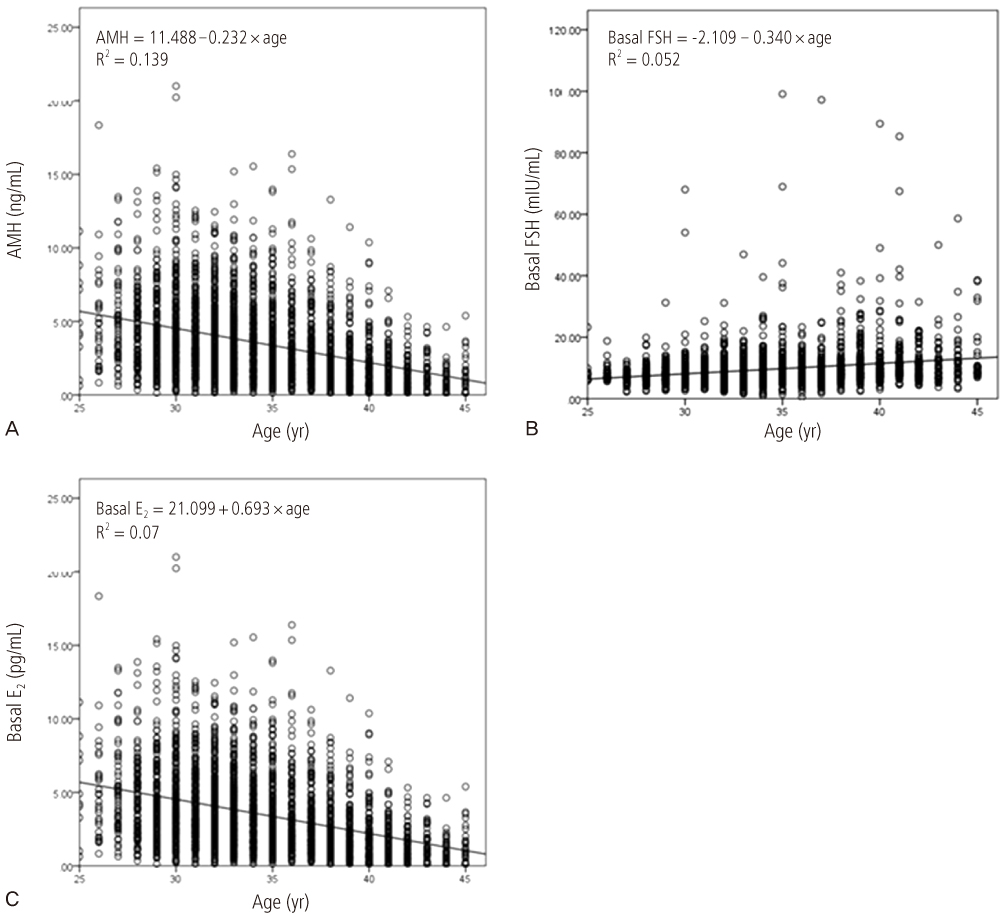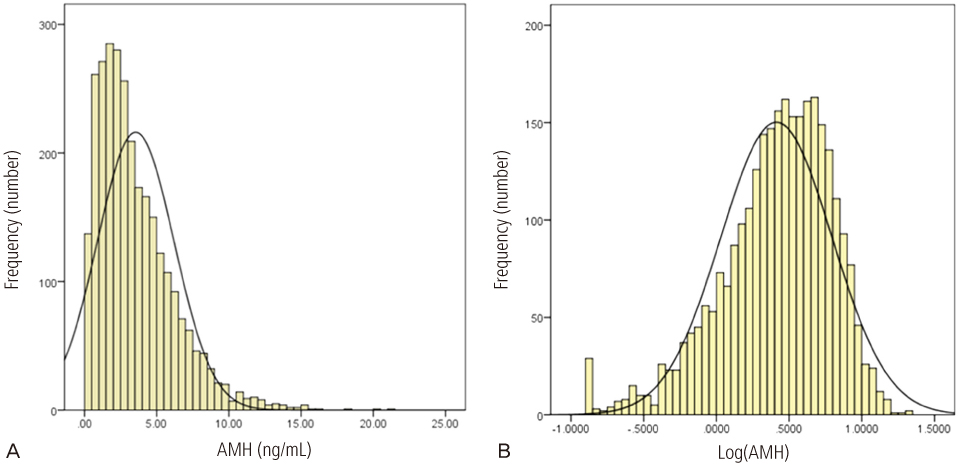Korean J Obstet Gynecol.
2012 Dec;55(12):920-928. 10.5468/KJOG.2012.55.12.920.
Age-related distribution of anti-Mullerian hormone levels in 2,879 Korean women with regular menstruation
- Affiliations
-
- 1Department of Obstetrics and Gynecology, CHA Gangnam Medical Center, CHA University, Seoul, Korea. mila76@naver.com
- 2Department of Statistics, Kangwon National University, Chuncheon, Korea.
- KMID: 2274198
- DOI: http://doi.org/10.5468/KJOG.2012.55.12.920
Abstract
OBJECTIVE
To determine the age-related distribution of anti-Mullerian hormone (AMH) in Korean women with regular menstruation who visited fertility center.
METHODS
Between May 2010 and April 2011, serum AMH levels on day 2-3 of a spontaneous menstrual cycle were evaluated in 2,879 women of reproductive age ranging from 25 to 45 years old, retrospectively.
RESULTS
The mean age was 34.2 +/- 4.3 years. The overall mean AMH value was 3.54 +/- 2.66 ng/mL (median, 2.9 ng/mL). Serum AMH level showed an age-dependent distribution and correlated negatively with age. Among multiple regression models, the quadratic model was most appropriated to describe the relationship between AMH and age (logAMH = -1.442 + 0.225 x age-0.004 x age2).
CONCLUSION
Our data showed reference values of serum AMH in Korean infertile women with regular menstruation. These values can be used as an important information of ovarian reserve for infertility patients and clinicians.
MeSH Terms
Figure
Cited by 2 articles
-
정상 월경을 가진 한국 여성의 항뮬러관호르몬의 연령별 참고치: 시간에 따른 추세 및 임상적 적합성 (2015-2021년)
Hee-Jeong Kim, Jin Young Park, Mi-Soon Han
Lab Med Online. 2022;12(1):46-52. doi: 10.47429/lmo.2022.12.1.46.Age Group-specific Reference Intervals for the Elecsys Anti-Müllerian Hormone Assay in Healthy Korean Women: a Nationwide Population-based Study
Misuk Ji, Kwang-Rae Kim, Hyun-Ki Kim, Woochang Lee, Yeo-Min Yun, Sail Chun, Won-Ki Min
Ann Lab Med. 2022;42(6):621-629. doi: 10.3343/alm.2022.42.6.621.
Reference
-
1. Weenen C, Laven JS, Von Bergh AR, Cranfield M, Groome NP, Visser JA, et al. Anti-Müllerian hormone expression pattern in the human ovary: potential implications for initial and cyclic follicle recruitment. Mol Hum Reprod. 2004. 10:77–83.2. La Marca A, Sighinolfi G, Radi D, Argento C, Baraldi E, Artenisio AC, et al. Anti-Müllerian hormone (AMH) as a predictive marker in assisted reproductive technology (ART). Hum Reprod Update. 2010. 16:113–130.3. Seifer DB, MacLaughlin DT, Christian BP, Feng B, Shelden RM. Early follicular serum Müllerian-inhibiting substance levels are associated with ovarian response during assisted reproductive technology cycles. Fertil Steril. 2002. 77:468–471.4. Fanchin R, Schonäuer LM, Righini C, Guibourdenche J, Frydman R, Taieb J. Serum anti-Müllerian hormone is more strongly related to ovarian follicular status than serum inhibin B, estradiol, FSH and LH on day 3. Hum Reprod. 2003. 18:323–327.5. Lee JY, Jee BC, Lee JR, Kim CH, Park T, Yeon BR, et al. Age-related distributions of anti-Müllerian hormone level and anti-Müllerian hormone models. Acta Obstet Gynecol Scand. 2012. 91:970–975.6. Yoo JH, Kim HO, Cha SW, Park CW, Yang KM, Song IO, et al. Age specific serum anti-Müllerian hormone levels in 1,298 Korean women with regular menstruation. Clin Exp Reprod Med. 2011. 38:93–97.7. Shebl O, Ebner T, Sir A, Schreier-Lechner E, Mayer RB, Tews G, et al. Age-related distribution of basal serum AMH level in women of reproductive age and a presumably healthy cohort. Fertil Steril. 2011. 95:832–834.8. Almog B, Shehata F, Suissa S, Holzer H, Shalom-Paz E, La Marca A, et al. Age-related normograms of serum antiMüllerian hormone levels in a population of infertile women: a multicenter study. Fertil Steril. 2011. 95:2359–2363.9. Nelson SM, Messow MC, Wallace AM, Fleming R, McConnachie A. Nomogram for the decline in serum antiMüllerian hormone: a population study of 9,601 infertility patients. Fertil Steril. 2011. 95:736–741.10. Seifer DB, Baker VL, Leader B. Age-specific serum anti-Müllerian hormone values for 17,120 women presenting to fertility centers within the United States. Fertil Steril. 2011. 95:747–750.11. Scott RT, Toner JP, Muasher SJ, Oehninger S, Robinson S, Rosenwaks Z. Follicle-stimulating hormone levels on cycle day 3 are predictive of in vitro fertilization outcome. Fertil Steril. 1989. 51:651–654.12. Levi AJ, Raynault MF, Bergh PA, Drews MR, Miller BT, Scott RT Jr. Reproductive outcome in patients with diminished ovarian reserve. Fertil Steril. 2001. 76:666–669.13. Toner JP, Philput CB, Jones GS, Muasher SJ. Basal follicle-stimulating hormone level is a better predictor of in vitro fertilization performance than age. Fertil Steril. 1991. 55:784–791.14. Scott RT Jr, Hofmann GE, Oehninger S, Muasher SJ. Intercycle variability of day 3 follicle-stimulating hormone levels and its effect on stimulation quality in in vitro fertilization. Fertil Steril. 1990. 54:297–302.15. Martin JS, Nisker JA, Tummon IS, Daniel SA, Auckland JL, Feyles V. Future in vitro fertilization pregnancy potential of women with variably elevated day 3 follicle-stimulating hormone levels. Fertil Steril. 1996. 65:1238–1240.16. Licciardi FL, Liu HC, Rosenwaks Z. Day 3 estradiol serum concentrations as prognosticators of ovarian stimulation response and pregnancy outcome in patients undergoing in vitro fertilization. Fertil Steril. 1995. 64:991–994.17. Smotrich DB, Widra EA, Gindoff PR, Levy MJ, Hall JL, Stillman RJ. Prognostic value of day 3 estradiol on in vitro fertilization outcome. Fertil Steril. 1995. 64:1136–1140.18. Evers JL, Slaats P, Land JA, Dumoulin JC, Dunselman GA. Elevated levels of basal estradiol-17beta predict poor response in patients with normal basal levels of follicle-stimulating hormone undergoing in vitro fertilization. Fertil Steril. 1998. 69:1010–1014.19. Seifer DB, Golub ET, Lambert-Messerlian G, Benning L, Anastos K, Watts DH, et al. Variations in serum Müllerian inhibiting substance between white, black, and Hispanic women. Fertil Steril. 2009. 92:1674–1678.20. Freeman EW, Gracia CR, Sammel MD, Lin H, Lim LC, Strauss JF 3rd. Association of anti-Müllerian hormone levels with obesity in late reproductive-age women. Fertil Steril. 2007. 87:101–106.21. Piouka A, Farmakiotis D, Katsikis I, Macut D, Gerou S, Panidis D. Anti-Müllerian hormone levels reflect severity of PCOS but are negatively influenced by obesity: relationship with increased luteinizing hormone levels. Am J Physiol Endocrinol Metab. 2009. 296:E238–E243.22. Jayaprakasan K, Campbell B, Hopkisson J, Johnson I, Raine-Fenning N. A prospective, comparative analysis of anti-Müllerian hormone, inhibin-B, and three-dimensional ultrasound determinants of ovarian reserve in the prediction of poor response to controlled ovarian stimulation. Fertil Steril. 2010. 93:855–864.
- Full Text Links
- Actions
-
Cited
- CITED
-
- Close
- Share
- Similar articles
-
- Age specific serum anti-Mullerian hormone levels in 1,298 Korean women with regular menstruation
- Correlation between the Serum Luteinizing Hormone to Folliclestimulating Hormone Ratio and the Anti-Mullerian Hormone Levels in Normo-ovulatory Women
- Age-Specific Reference Values of Anti-Müllerian Hormone in Korean Women with Normal Menstruation: Time Trend and Clinical Suitability (2015–2021)
- Impact of hysterectomy on ovarian reserve in early postoperative period
- The Author Response: Serum anti-Mullerian hormone levels and phenotypes of polycystic ovary syndrome





